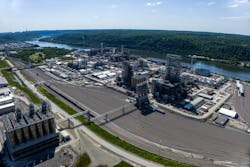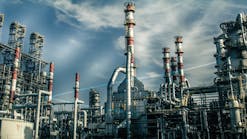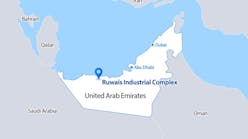Shell’s Monaca chemical complex preps for official commissioning
Shell PLC subsidiary Shell Chemical Appalachia LLC is nearing official startup of its long-planned Shell Polymers Monaca petrochemical complex atop a 386-acre site just southwest of Monaca, Pa., along the Ohio River in Potter and Center Townships, Beaver County, 30 miles northwest of Pittsburgh (OGJ, Aug. 3, 2020, p. 35).
After resuming full-construction activities in first-half 2021 following pandemic-related slowdowns and delays, by midyear 2022 Shell was initiating routine integrity and safety testing of equipment at Monaco as part of its standard commissioning and startup (CSU) works when bringing nearly completed plants online.
With commissioning of some critical plant equipment previously achieved in early 2022, the Monaca petrochemical manufacturing site—which features a dual 1.5-million tonne/year (tpy) ethylene and 1.6-million tpy polyethylene complex—is scheduled for full startup by yearend 2022 (Fig. 1).
Latest developments
On June 27, Shell Pennsylvania Chemicals (SPC) confirmed via its official Facebook page ongoing CSU progress at the complex, including the start of a series of weekly tests to ensure integrity and safety of equipment recently put into operation.
While SPC’s post identified neither the duration of the CSU testing phase nor the specific units at which the tests were occurring, the official social media announcement came on the heels of confirmation by Jim Sewell—Shell Chemical Co.’s environmental manager—during his June 16 keynote address to Appalachian Energy Innovation Collaborative’s conference in Canonsburg, Pa., that the Monaca complex had reached 98% completion and was tentatively slated to become fully operational within a couple of months.1
The June project updates followed a series of announcements earlier in the year regarding milestones achieved at the Monaco construction site, the most recent of which included the operator completing pilot lighting of elevated and ground flares on the complex’s west side in mid-March to prepare the site for “receiving materials in support of [its] eventual operation this summer” (Fig. 2). SPC also said it was scheduled on Mar. 19 to complete the final series of steam blows to clean out piping of the site’s polyethylene units ahead of entering those units into operation.
SPC previously announced it had completed commissioning of the cracked gas compressor (CGC) of the Monaca complex’s main ethane cracking unit (ECU) and plant. Built locally by Jeannette, Pa.-based Elliott Group, the 100,000-hp, steam-driven turbine, five-stage CGC will enable the ECU’s cracking of ethane gas, beginning the process that allows the complex to clean and separate various by-products for distribution to and use by other parts of the plant, SPC said.
SPC commissioned the site’s cogeneration unit with steam and begun steam blow for the complex’s ECU in 2021.
Shell Polymers Monaca also has started a fence-line monitoring program at the complex which entails bi-weekly passive sampling for emissions of chemicals of potential concern, including benzene, hexane, 1-3 butadiene, toluene, and naphthalene, according to the operator’s website. To conduct this monitoring, Shell has installed 20 passive air monitoring systems (PAMS) across the site (Fig. 3).
Ongoing CSU activities at Monaca in 2021-22 follow the Pennsylvania Department of Environmental Protection’s (DEP) February 2021 approval of modified air quality plans for which Shell Chemical Appalachia applied in December 2019 and February 2020. The plans were part of a request for authorization of as-built changes in design and construction of the Monaca site. Proposed changes included minor equipment additions, removal and downsizing of permitted equipment, and changes in capacities of pumping, incineration, blending, heating, storage, loading, water circulation, and flaring equipment, DEP said.
Shell, which in July 2020 completed divestment of its Appalachia oil and gas production assets—including 443,000 net leasehold acres across Pennsylvania with 358 producing wells in the Marcellus and Utica shale formations—as well as all owned and operated midstream infrastructure, has yet to reveal details regarding supply agreements with regional gas operators for the ethane required to feed the Monaca cracker project (OGJ Online, May 5, 2020).
The operator has, however, confirmed the Monaca complex will receive the entirety of its regionally-sourced ethane feedstock via Shell Pipeline Co. LP’s Falcon ethane pipeline system (FEPS), a 97-mile common carrier ethane pipeline that—stretching across southwestern Pennsylvania, West Virginia and eastern Ohio—connects Monaca with three major ethane source points in the rich-gas portions of the Marcellus and Utica shale reservoirs: Houston, Pa.; Scio, Ohio; and Cadiz, Ohio.
Shell Pipeline—which reached mechanical completion of the project in 2020—formally commissioned the FEPS in October 2021, according to Shell’s website.
While Shell has yet to officially confirm its total capital investment in the Shell Polymers Monaca complex, an updated economic impact analysis (EIA) of the project completed by Robert Morris University professors in 2021 estimated overall cost of the project has increased to at least $10 billion from its 2014 original price of $6 billion.
Complex overview
Designed to produce ethylene, high-density polyethylene (HDPE), and linear low-density polyethylene (LLDPE) from nearby supplies of Marcellus and Utica shale ethane, Shell’s Appalachian petrochemical manufacturing site will house seven tail gas and natural gas-fired ethane cracking furnaces with a heat input rating of 620 MMbtu each to support the ethane cracker and three polyethylene units, according to the latest project documents.
The complex’s two gas-phase polyethylene manufacturing lines each will be equipped to produce 550,000 tpy of either HDPE or LLDPE-grade pellets, while a third manufacturing line outfitted with INEOS AG’s slurry-loop reactor polyethylene technology will produce 500,000 tpy of HDPE pellets. Alongside installations for steam generation, storage, logistics, cooling water, and wastewater treatment, the complex also will house a 250-Mw cogeneration power unit that uses natural gas and steam to meet the site’s full electricity requirement.
Water use
The complex will recycle and reuse water in its processes, drawing about 20 million gal/day from the Ohio River. While about 80% of water used at the site will evaporate as clean steam, the rest will be treated as necessary to remove impurities and tested to ensure it meets water quality standards before supplies are returned to the river.
Water treatment measures will include:
- Recycling condensate (condensed steam from pro-cess equipment).
- Building retention ponds for storm water; water will be tested and treated as needed and then discharged to the river.
- Implementing procedures to avoid, mitigate, and quickly respond to spills before they reach water.
- Installing groundwater monitoring wells to validate protection measures are working as designed and conducting regular water-quality testing.
- Making shoreline improvements for erosion protection along the Ohio River bank adjacent to the complex.
- Enhancing and preserving in-kind habitats in the same watershed to offset impacts to wetlands and streams on the site.
Emissions controls
Already set to be equipped with the most recent (but yet-to-be-identified) digitalization technologies to maximize energy efficiency and minimize emissions, Shell said the complex also will feature secondary measures to limit emissions from the site.
These secondary measures will include:
- Recycling of tail gas—a by-product of the ethane cracking process primarily composed of clean-burning hydrogen—to power the ethane cracker furnaces.
- Undertaking other measures to eliminate visible flaring, except for flaring required during initial startup and emergency situations, such as a total regional power failure.
- Using natural gas-fired cogeneration to provide steam and electricity for the project and selling excess electricity to the grid for regional use, displacing other higher-emission sources.
- Eliminating the environmental impacts of both transporting ethane to the US Gulf Coast for processing and shipping polyethylene back to the region.
On-site technologies
While Shell has not disclosed full details of specific production technologies implemented at the Monaca site, the operator has confirmed via its project website that the Monaca complex has been outfitted with Industry 4.0 polymer technology such as advanced analytics, cloud-based technologies, robotics, and artificial intelligence (AI; machine learning). Other implementations include, though are not limited to:
- Predictive maintenance.
- Digital sensors.
- Drone technology.
The site’s predictive maintenance program combines embedded sensors, analytic models, and AI to help avert trips and failures in critical equipment. Shell said these sensors will track key plant variables such as temperature, pressure, and vibration, with AI algorithms learning to identify when issues are developing.
Additionally, plant data and documents will be stored in a smart, unified, digital platform that reaches across the engineering, procurement, and construction functions, allowing plant personnel to search for the latest engineering documentation and access related information—including unit locations, technical drawings, specifications, maintenance records, and history—via tag searches. Plant workers also will be equipped with tablets in the field, allowing instant uploading of data into the real-time digital platform, as well as enabling access to full work-order details and notifications to help reduce time of routine inspections. In addition to supporting field workers’ maintenance execution and ensuring safe production processes, Monaca’s implementation of mobile digital forms will contribute to limiting operational problems and reducing polyethylene supply chain delays, Shell said.
Safety features implemented at Monaca include real-time gas monitors, fall protection, and a drone-monitoring and inspection program, the latter of which aims to help eliminate the need for plant personnel to physically carry out inspection works at increased elevations more easily accessed by drones, according to the operator.
References
- Gough, P.J., “Shell exec provides update on Beaver County plant,” Pittsburgh Business Times, Jun. 16, 2022.

Robert Brelsford | Downstream Editor
Robert Brelsford joined Oil & Gas Journal in October 2013 as downstream technology editor after 8 years as a crude oil price and news reporter on spot crude transactions at the US Gulf Coast, West Coast, Canadian, and Latin American markets. He holds a BA (2000) in English from Rice University and an MS (2003) in education and social policy from Northwestern University.


